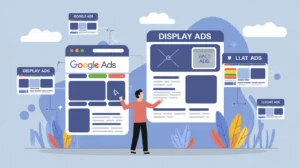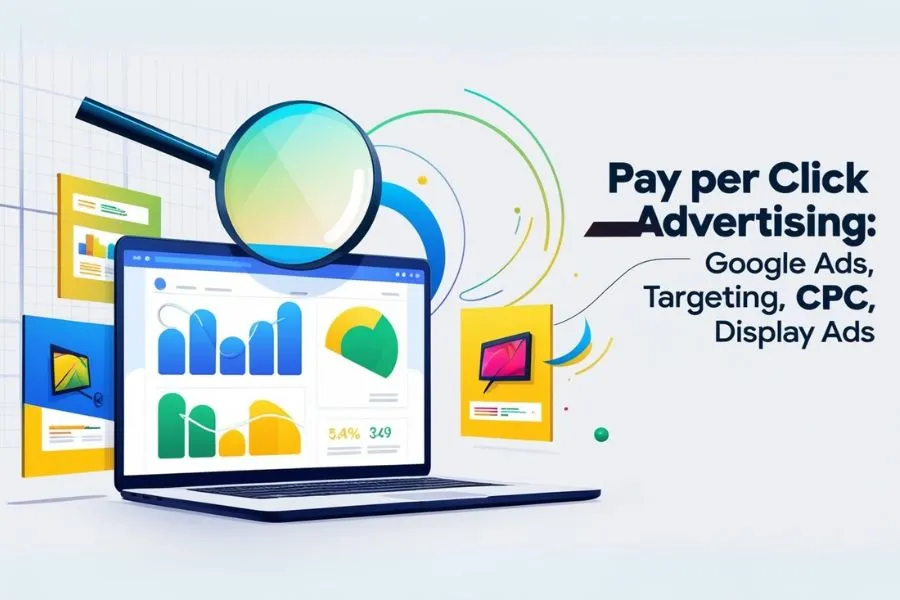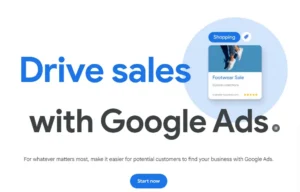Introduction to Pay Per Click Advertising
In present digital era, Pay Per Click Advertising (PPC) has become a cornerstone for businesses aiming to capture targeted traffic, drive sales, and maximize ROI. With platforms like Google Ads, PPC offers a unique advantage by allowing advertisers to pay only when users click on their ads. This approach ensures that every dollar spent contributes directly to audience engagement.
But PPC isn’t just about creating ads—it’s about understanding key components like Ad Targeting, Keyword Bidding, and Cost-Per-Click (CPC). Additionally, incorporating Display Ads in your strategy can broaden your reach and keep your brand top of mind. Let’s dive deeper into each aspect to master PPC like a pro.
Google Ads: The Powerhouse of PPC
Google Ads is the undisputed leader in PPC advertising, controlling a significant portion of the search ad market. Its platform enables businesses to display their ads on Google Search, YouTube, and across millions of partner websites.
Features of Google Ads:
- Customizable Campaigns
Advertisers can create campaigns tailored to their goals—whether it’s sales, leads, or brand awareness. For instance, a fitness brand might use Google Search Ads to target keywords like “best gym equipment” or “personal training near me.” - Diverse Ad Formats
From responsive search ads to video ads, Google Ads offers versatile formats to suit different business objectives. - Comprehensive Analytics
Tools like Google Analytics integration allow advertisers to track performance metrics like impressions, clicks, and conversions.
Example of Success:
A small bakery in Los Angeles used Google Ads to promote its gluten-free product line. By targeting local search terms like “gluten-free bakery LA,” the bakery increased foot traffic by 40% in just three months.
Ad Targeting: Reaching the Right Audience
Effective ad targeting ensures that your ads are shown to people most likely to engage with your brand. Google Ads offers a variety of targeting options, enabling you to refine your audience.
Key Ad Targeting Techniques:
- Demographic Targeting
Tailor your ads based on age, gender, income, and more. For example, a luxury watch brand might target high-income males aged 30–50. - Geographic Targeting
Perfect for businesses with a local presence. A car repair service in New York City could target users within a 10-mile radius. - Behavioral Targeting
Use data on user behavior, like previous searches or site visits, to deliver personalized ads.
Pro Tip:
Combine audience insights with retargeting campaigns. For instance, if someone visited your website but didn’t make a purchase, use display ads to remind them about your products.
Keyword Bidding: Winning the Auction
At the heart of PPC lies Keyword Bidding—the process of competing for ad placements in search results. The higher your bid and the better your ad relevance, the higher your chances of securing prime ad space.
Types of Keyword Bidding Strategies:
- Manual Bidding
It relates to how much you’re paid for each click. This is ideal for businesses on a tight budget. - Automated Bidding
Google adjusts your bids automatically based on the likelihood of conversions. For example, an e-commerce store selling electronics might use Target ROAS (Return on Ad Spend) to maximize profitability.
Example in Action:
A travel agency bidding on “affordable Europe tours” set a maximum CPC bid of $2.50. They optimized their ad copy and landing page, eventually reducing their average CPC to $1.75 while increasing click-through rates (CTR) by 25%.
Cost-Per-Click (CPC): Managing Your Budget
Understanding Cost-Per-Click (CPC) is essential for maintaining a profitable PPC campaign. CPC is cost of each click on your ad.
Factors Influencing CPC:
- Ad Quality Score
Google rewards ads with high relevance and better user experience by lowering CPC. Focus on writing engaging ad copy and creating optimized landing pages. - Competition
Highly competitive keywords like “best CRM software” tend to have higher CPCs compared to niche terms. - Bid Strategy
Balancing your bids with campaign goals is critical. Lowering bids might reduce visibility, while overly aggressive bidding can drain your budget.
Quick Calculation:
If your monthly PPC budget is $1,000 and your average CPC is $2, you can expect around 500 clicks. Keep monitoring CPC trends to ensure your strategy aligns with your goals.
Display Ads: Enhancing Brand Visibility

While search ads focus on intent, Display Ads excel at capturing attention and driving awareness. These visually appealing ads appear across websites, apps, and videos in the Google Display Network.
Why Use Display Ads?
- Broader Reach
Access millions of websites to target potential customers beyond search results. - Remarketing Opportunities
Display ads are perfect for reminding previous visitors about your products or services. - Cost-Effectiveness
CPC for display ads is generally lower than search ads, making them a great choice for awareness campaigns.
Example:
A SaaS company targeting startups created banner ads with compelling visuals and clear CTAs like “Start Your Free Trial.” The result? A 30% increase in sign-ups within a month.
Conclusion: Mastering PPC for Business Success
Pay Per Click Advertising isn’t just a tool—it’s a game-changer for businesses of all sizes. By leveraging the full potential of Google Ads, fine-tuning your Ad Targeting, mastering Keyword Bidding, monitoring CPC, and using Display Ads, you can create campaigns that deliver exceptional results.
Whether you’re a startup or a well-established brand, PPC offers unparalleled opportunities to grow and thrive in the digital space. The key lies in continuous learning, optimization, and adaptation to industry trends.
Ready to elevate your PPC game? Start experimenting with Google Ads today and watch your business soar!
FAQs
1. What is Pay Per Click Advertising?
PPC is a digital marketing strategy where advertisers pay a fee each time their ad is clicked, driving traffic to their websites.
2. What is Ad Targeting in PPC?
Ad targeting involves refining your audience based on demographics, location, behavior, and other factors to ensure your ads reach the right people.
3. How can I reduce my CPC in Google Ads?
To lower CPC, focus on improving your Quality Score by creating relevant ad copy, refining keywords, and optimizing landing pages.
4. Are Display Ads effective for lead generation?
Yes, display ads are highly effective, especially when combined with retargeting strategies. They help maintain brand awareness and attract potential leads.
5. What is Keyword Bidding in PPC?
Keyword bidding is the process of setting the maximum amount you’re willing to pay for a click on a specific keyword in a PPC campaign.


